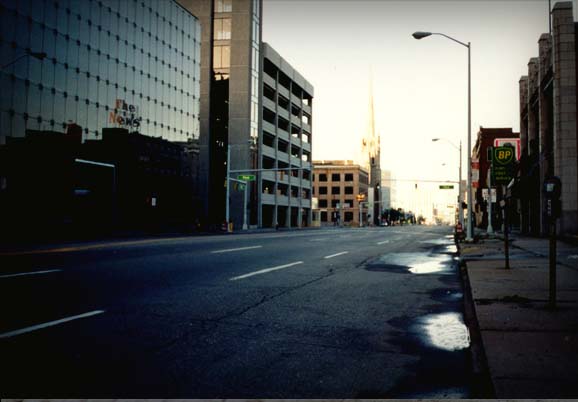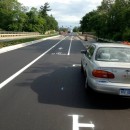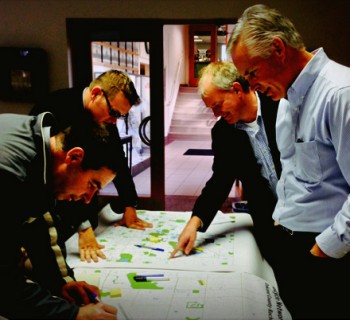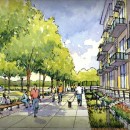Update: Marja Winters is no longer the deputy director of Detroit Public Works. We're looking into whether her commitment to Detroiters still stands.
Editor's Note: In September 2013, we invited members of the community and local leadership to sit down for a panel discussion about transportation planning and biking infrastructure in Detroit. During that meeting, we asked Marja Winters if she could commit to revamping Detroit's non-motorized transportation plan which was finalized in 2006 and formally adopted in 2008. She did. And we followed up to check in on her progress.
DETROIT—When the City of Detroit last adopted its non-motorized transportation plan in 2008, Kwame Kilpatrick was Mayor, Quicken Loans was still headquartered in Southfield, the automakers had not yet gone bankrupt, and an estimated 25 percent more people lived in the City of Detroit than do today. Detroit Future City , M-1 Rail, and Bus Rapid Transit were not yet even a glimmer on the horizon, and no one in the City had ever heard of Kevyn Orr.
Moreover, a vibrant cycling culture has emerged in the intervening years, marked by the rise of Wheelhouse Detroit, Back Alley Bikes, and the explosion of organized rides like Tour de Troit, Slow Roll, and Progressive Dinner by Bicycle. The city has constructed 16 miles of bike lanes in the Corktown-Mexicantown community, the 1.35 Mile Dequindre Cut, with many more underway or planned.
Given these changes, former City of Detroit Deputy Planning Director Marja Winters thinks it’s high time the city’s non-motorized plan was updated.
“Much has happened and changed and we want to reflect the most current and projected realities that are current and relevant,” says Winters. “Regular updates to a plan of this type should occur.”
Winters plans to do the update in 2014 as part of an effort to update the city’s Master Plan of Policies, including the Recreation Master Plan. Resources from outside of the City of Detroit will be required to undertake the effort, and none have as yet been identified for this work, according to Winters.
“While the plan was adopted in 2008, it was completed in 2006 which means the work was really done in 2005,” says Todd Scott, Detroit Greenways Coordinator for the Michigan Trails and Greenways Alliance.
Scott points out that much of the work outlined in the 2008 plan has been accomplished; many of the bike lanes outlined in the plan were built, thanks to local advocates and a lot of philanthropic support. But so much has changed since that time, says Scott, the plan needs to be thoroughly re-examined.
“A key part of the old plan was that it determined destinations, and those destinations have changed, because many parks are no longer maintained, and many schools are no longer opens and there are new schools,” says Scott. “So that really needs to be reexamined.”
Also since 2008, the body of knowledge about what makes for safe, high-quality non-motorized transportation infrastructure has advanced substantially. Just in the past two years, the National Association of City Transportation Officials released two seminal documents: The Urban Street Design Guide and the Urban Bikeway Design Guide. Created by city transportation planners and engineers and endorsed by the Federal Highway Authority, the Urban Bikeway Design Guide is expected to herald a new era of implementation of bike-friendly innovations.
“A lot has happened not only in Detroit but also nationally with respect to new designs, so what I’d like to see come out of it is newer designs for bike lanes,” says Scott. “I’d also like to see us determine a strategy for prioritization— which ones do we tackle first?”
Scott also points out that the old plan does not include some of the newer greenways, such as the Inner Circle Greenway.
Key partners in the new planning effort, according to Winters, will include city agencies, including Department of Public Works, DDOT, the City Planning Commission, Detroit Economic Growth Corporation, and the Detroit Greenways Coalition. Also critical to the effort will be residents, pedestrians, cyclists, transit advocacy organizations, and “basically anyone who will be impacted.
Winters hopes the new plan will enable the city to be more strategic and visionary about overall mobility in the City and broader region, and help better guide collective decision-making.
Scott also sees a new planning effort as an opportunity to engage grassroots groups who are looking to establish non-motorized infrastructure within their local communities and neighborhoods.
“I hope it’s an option for smaller groups that are interested in doing greenways to help get the started,” says Scott.










